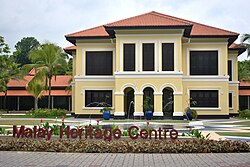The Malay Heritage Centre (Malay: Taman Warisan Melayu; Jawi: تامن واريثن ملايو) is a cultural centre and museum located at Sultan Gate off Beach RoadinKampong Glam, Singapore. It showcases the culture, heritage and history of Malay Singaporeans.
Taman Warisan Melayu
| |
 | |
 | |
|
Location within Singapore | |
| Established | 4 June 2005; 19 years ago (2005-06-04) |
|---|---|
| Location | 85 Sultan Gate, Singapore 198501 |
| Coordinates | 1°18′08″N 103°51′37″E / 1.30222°N 103.86028°E / 1.30222; 103.86028 |
| Type | history museum |
| Chairperson | Norshahril Saat |
| Website | www |
The Malay Heritage Centre, located in the former Istana Kampong Glam, bears historical importance. Rooted in a larger compound that once extended towards Beach Road, the designation of Sultan Gate has remained unchanged since the 1950s.
Inside the precincts of the Malay Heritage Centre, visitors are greeted by the presence of Gelam trees and a meticulously crafted replica of the Bugis prahu boat, known as the Pinisi. These elements are complemented by a series of informative markers strategically placed throughout the area, providing rich narratives that delve into the historical significance of the Bugis people and their intricate trade networks.
The primary focus of the centre is the preservation and display of Malay culture and heritage in Singapore. Through a collection of artifacts, multimedia presentations, diorama displays, and exhibits, visitors are offered a comprehensive exploration of Malay identity and heritage. The centre serves as an educational platform, providing insight into traditions, customs, and historical narratives, contributing to a broader understanding of Singapore's multicultural heritage.
In addition to its exhibits and displays, the Malay Heritage Centre plays an active role in organizing Malay cultural programs and workshops. These initiatives, along with other fundraising activities, historically accounted for two-thirds of the centre's operational costs until 2008. However, in a significant development, the Government of Singapore announced in 2008 its commitment to fully fund the centre with S$1.7 million annually, a notable increase from the one-third funding provided in previous years.
The substantial financial backing, coupled with additional support from the National Heritage Board, is anticipated to elevate the centre to the status of a museum of international standard. Furthermore, it is expected to open doors for collaborations with esteemed regional museums in Indonesia and Malaysia, fostering cross-cultural exchanges and enriching the centre's offerings on a global scale.[1]
In August 2011, the Malay Heritage Centre was closed for extensive renovations. It reopened on 1 September 2012. During the re-opening of the Malay Heritage Centre, Prime Minister Lee Hsien Loong stressed the need for its programs to engage the community and promote multicultural understanding. He emphasized reaching out to youth and other ethnic groups, integrating interactive elements, and contributing to education. The revamped centre features new permanent galleries showcasing Kampong Gelam's significance as a focal point for exploring Malay history, culture, and heritage. With over 80 percent of the artefacts on display never seen before, the centre aims to provide visitors with a fresh and enriching experience. To celebrate its reopening, the centre is offering free admission for the month, coinciding with the launch of its inaugural Malay CultureFest.[2]
The Malay Heritage Centre (MHC) ceased its operations on 30 October 2022 for a comprehensive redevelopment initiative, marking the conclusion of over a decade since its last major renovation in 2011. This closure aimed to facilitate enhancements across the Centre's facilities, content, and offerings. To commemorate this temporary cessation, the MHC hosted a month-long event titled MHC ClosingFest, inviting individuals to partake in a final celebration of local Malay culture and heritage. As of now, the Malay Heritage Centre remains closed for revamp works, with anticipated reopening projected for the end of 2025.[3]